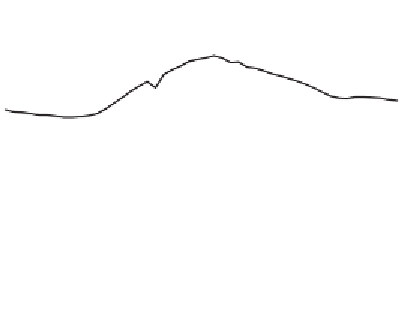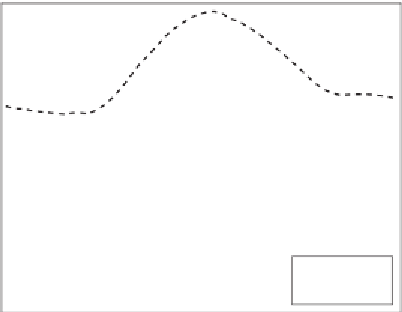Geoscience Reference
In-Depth Information
600
500
400
300
200
100
plants
soil
0
0
3
6
9
12
15
18
21
24
Time (hour UTC)
Figure 2.15
Upwelling longwave radiation as observed at a vineyard site in Central
Spain (Tomelloso), June 12, 1991. Radiation has been measured separately above the
vine plants, and the bare soil in-between.
Typical values for the surface emissivity can be found in
Table 2.1
. For most sur-
face types
ε
s
is between 0.9 and 0.99. This implies that there is
some
relection of
longwave radiation.
2
Hence, the total upwelling longwave radiation is the sum of the
emitted radiation,
L
e
↑
(see earlier) and the relected radiation:
↑
↑
1
ε
↓
(2.28)
LL
=+−
e
(
)
L
s
Figure 2.14b
shows observations of
L
↑
for two days. For the cloud-free day, the diur-
nal cycle of
L
↑
is larger than for the overcast day. During daytime the higher value of
L
↑
is due to the larger insolation that results in a higher surface temperature. During
night time the surface temperature under cloud-free conditions drops lower than for
the night with clouds, mainly because the incoming longwave radiation is smaller
(see
Figure 2.14a
).
But the surface temperature is not only coupled to variations in the total incoming
radiation (shortwave and/or longwave). Another important factor that determines the
surface temperature is the partitioning of the available energy between evapotrans-
piration and sensible heat lux. This is illustrated in
Figure 2.15
showing observa-
tions made over a sparse vegetation (mixture of plants and bare soil) in Spain. The
upwelling longwave radiation has been measured separately above the plants (which
actively transpire) and the dry bare soil. It is clear that the plants emit much less
longwave radiation than the bare soil because the surface temperature of the plants is
2
Per Kirchhoff's law, spectral absorptivity (
α
λ
) equals spectral emissivity (
ε
λ
). For an opaque surface, the relectiv-
ity,
r
λ
then equals 1-
α
λ
= 1 -
ε
λ
. If we extend this to broadband values, integrated over the longwave wavelength
region,
r
long
becomes (1-
ε
s
).



































Search WWH ::

Custom Search